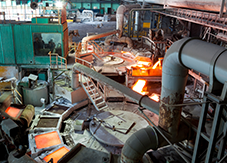Steel Tube Mill Hydrotester Repair

The 15,000 PSI Hydrostatic Tube and Pipe testing mill sealing surface heads, at a major manufacturer of pipe and tube, had become cracked.
The 15,000 PSI Hydrostatic Tube and Pipe testing mill sealing surface heads, at a major manufacture of pipe and tube, had become cracked. The surface of the fill and purge head blocks in the hydrotester require a fine, indication-free finish on the sealing surfaces. The surfaces had become cracked to such an extent that, while the testing machine could still maintain a 15,000 PSI hydrostatic test pressure, excessive amounts of water were being wasted during the test process. The material of the head blocks, AISI 4340 Nickel – Chrome –Moly, requires specialized weld media and pre and post weld heat treatment procedures in order to prevent cracking.
During the preliminary client interview, TEAM learned that the prior vendor’s repair was completed using local torch preheat only, standard carbon steel compatible electrodes and without post weld stress relief. TEAM advised the client to be prepared for indications of discontinuity deeper than expected due to the uncontrolled processes previously used which we expected to be revealed after the initial pre-machining process.
TEAM offered an engineered six step controlled process as a solution, which was reviewed and accepted by the owner.
Step one: An on-site machining clean up cut of the 22" diameter sealing surface of the heads commenced (utilizing a TEAM manufactured Silk® portable facing machine) with periodic PT until it was verified that all indications of discontinuity (cracks) were removed. The pre-machining excavation depth was roughly twice client expectations, due to the errant weld methods used previously—certain indications were deep enough to require hand grinding, to preserve as much parent metal as possible.
Step two: The fill and purge head blocks were preheated and the temperature held.
Step three: The critical 22" diameter sealing surfaces of the heads were welded with the proper low hydrogen electrodes, per weld procedure requirements. Sufficient material was applied raising the sealing surface higher than the OEM finish surface height.
Step four: The facing machine was repositioned to the datum points and the overlay of weld was machined to a flatness tolerance of 0.001" overall.
Step five: The sealing surfaces were honed to create a surface finish of 32 RMS, which was required to satisfy the sealing criteria.
Step six: The fill and purge head blocks were post weld stress relieved and then ambient air quenched. The client’s post weld heat treatment specification required surface hardness of between 25 – 29 Rockwell “C” and required a Grain/Yield Strength of 90,000 psi minimum—both were achieved. The honing provided the required super fine OEM 32 RMS finish to the sealing surfaces. Ultrasonic examination according to ASTM E-114 after TEAM’s restoration of the hydrotester purge heads verified that the heads were repaired to the OEM condition. The entire repair took fourteen consecutive twelve-hour shifts and the client was impressed with TEAM’s results.